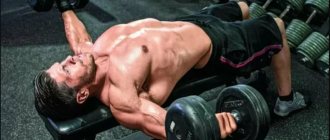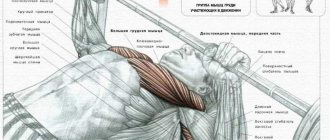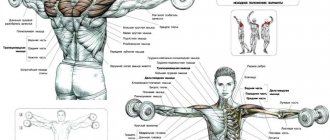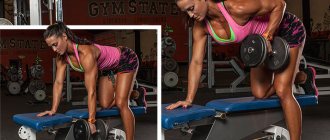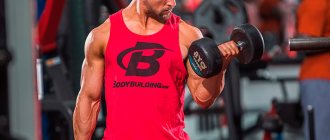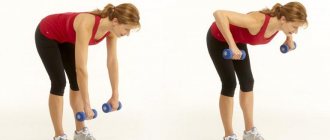Benefits and harms
In bodybuilding, dumbbell lifts are used to gain muscle mass and give relief, and in fitness to lose weight and maintain tone. From the exercise, the chest becomes more convex, and the chest increases in volume. A distinct boundary is also formed between the right and left pectoral muscles.
However, if you have just started training, give preference to basic exercises. Isolated people are too dangerous for you.
Improper execution technique leads to damage to the shoulder joint.
Execution technique and exercise options
Take the starting position, holding dumbbells in your hands. Press your head, shoulders and buttocks to the bench, and your feet to the floor. Feet are shoulder width apart.
Bend your arms at the elbow at an angle of 150-160 degrees (the angle remains unchanged during the exercise) and raise them exactly above your chest so that the dumbbells almost touch each other.
As you inhale, spread your arms out to the sides to shoulder level. Elbows point down. Having reached the lowest point, stay in this position for a couple of seconds until you feel slight muscle pain. Try to protrude your chest as much as possible for better muscle stretching and oxygen saturation.
To avoid injury, there should be no discomfort in the ligaments and joints. If you experience pain, then most likely you chose a projectile that is too heavy.
As you exhale, lift the dumbbells again along the same path to the starting position and pause for a few seconds to feel the maximum muscle contraction. Perform all movements smoothly.
Other options for the exercise are wiring in a butterfly simulator or on a crossover block. However, in the butterfly simulator, the load is applied only to the central part of the chest, but performing crossover flyes while lying on an inclined bench can completely replace dumbbells.
For beginners, girls and women, I recommend doing the crossover exercise. The shoulder joint is less injured, and the chest muscles are well worked out.
If you are a strong and fit person, use the dumbbell option. This will allow you to lift significant weights and better pump your upper chest.
At the end of the article I have provided a video that will help you understand the correct exercise technique.
Execution technique
Initial position:
- Adjust the angle of the bench from 30 to 40 degrees.
- Take a dumbbell in both hands and take your starting position lying on an incline bench, face up.
- Press your shoulder blades tightly against the back of the support, and place your feet on the floor on both sides of the bench.
- Raise the implements above your chest, holding them in your arms slightly bent at the elbows. The grip used is neutral - with palms facing each other.
Movement:
- Without changing the angle in the elbow joints, while inhaling, slowly and under control, move the dumbbells to the sides until you feel a stretch in the pectoral muscles.
- As you exhale, using isolated force from your pectoral muscles, lift the dumbbells up in a wide arc, bringing them together above your chest.
- Perform a brief isometric contraction of the pectoral muscles in the top position.
- Following the given pattern, perform the planned number of repetitions.
Attention!
Recommendations!
Execution options
Example workout
Warm up before training to protect yourself from injury. The muscles will warm up and be ready for intense work. Dumbbell flyes are isolating, so they should be performed only after basic chest exercises: bench press, push-ups. Depending on where you perform it, the workout may vary slightly.
At home
When training at home, as a rule, there is no access to a wide range of exercise equipment.
- As a warm-up and basic exercise, perform push-ups. 4 sets of 20 repetitions will be enough.
- Next, perform dumbbell presses on a horizontal or inclined bench - 3 sets of 10-12 repetitions.
- After the bench press, start doing dumbbell flyes. Perform 3-4 sets of 10 repetitions.
In the gym
There are a lot of sports equipment in the gym, so perform bench press (4 to 12) and dips (3 sets to the maximum) as basic ones.
- Additionally, warm up your shoulder joints by performing a couple of crossover sets with light weights for 15-20 repetitions.
- Next, perform dumbbell flyes - 3 sets of 10 repetitions.
- Rest no more than 2 minutes between sets, and no more than 4 minutes between exercises.
- At the end of your workout, do some stretching. To do this, clasp your hands behind your back, squeezing your shoulder blades together, and hold in this position for 30-40 seconds. Or hang on the bar for 30 seconds.
After training, do not forget to give your muscles proper rest. For the chest, one quality workout per week is enough.
Varieties and technique of execution
Technically, dumbbell raises in a lying position are performed identically in all variants. Only the position of the bench changes. It is recommended to alternate all available types of exercise, providing the muscles being worked with a complex load.
On a horizontal bench
The technique for performing the classic version of the exercise is as follows:
- Sitting in the middle of the bench, place the dumbbells with the butts on your thighs closer to the pelvis, holding them with a neutral grip (hands facing each other).
- Having rounded your back, lie down so that the area from the pelvis to the back of the head is pressed against its surface. In the process, bring your arms up, at mid-chest level.
- Bend your elbows at an angle of 10–15º. Place the entire surface of the foot on the floor, resting firmly. Slightly arch your lower back and squeeze your shoulder blades together.
- Slowly raise your arms until they are parallel to the floor or slightly lower. Stop when you feel a stretch in your pectoral muscles. Hold for a couple of seconds, focusing on this feeling.
- With the same controlled movement, return the shells to the top.
After mastering the basic technique, you can try to complicate the exercise: during the lifting process, turn your hands with your little fingers towards you or with your palms facing forward.
To warm up, trainers advise doing one approach with minimal weight. For women, 2-3 kilograms are enough, for men - 5-7 kilograms. Number of repetitions - up to 15.
Tilt up
When performing dumbbell flyes on an inclined bench with your head up, the emphasis in the load shifts to the upper part of other muscles. They are targeted relatively rarely, so sometimes asymmetry arises that needs to be eliminated. For women, the exercise is indicated to improve the appearance of the décolleté area.
You need to lie down with the back of the bench tilted at an angle of 20–45 degrees. Less does not make sense - the load shifts to the front deltoids. Here you also need to carefully monitor the level of lowering of the elbows.
With a downward slope
Flying dumbbells on a bench while lying upside down allows you to work with heavier weights. The process involves the lower part of the pectoral muscles. Shifting the emphasis helps emphasize the shape of the breasts.
When lying down on a bench, it is important to take the weight correctly. You can lie down on your own with light dumbbells, pressing your arms bent at the elbows tightly to your body. It is better to let the belayer deliver the heavier shells.
It is strongly not recommended to work with close to the maximum weights in this position. This increases the load on the blood vessels, and surges in blood pressure and attacks of dizziness are very likely. The restriction is especially relevant for elderly people.
Tips for implementation
Sets and reps
Since training the chest muscles is not limited to just doing exercises on the bench, it is advisable to save energy for performing other exercises. It will be enough to perform 3-4 sets of 6-10 repetitions. For strength, do 6 reps, and for volume, do 10 reps.
Dumbbell weight
The mass of the projectile should not be too large, otherwise the execution technique will be disrupted. If you're just learning the technique, use a weight that you can do 12-15 reps with. Having mastered it, you can take a load that allows you to do no more than 6-10 repetitions.
Tilt angle
The fly is performed on an inclined bench, the back of which is at an angle of 30-45 degrees to the floor. This angle allows you to best work the pectoral muscles. As the angle of inclination increases, the load moves from the chest to the delta. As the angle approaches the horizontal position, the entire load transfers to the middle part of the chest, while the upper part remains unworked. This makes the breasts flat, depriving them of the desired volume.
Dumbbell flyes lying on an incline bench
This exercise allows you to work the upper and lower parts of the pectoral muscles. There are two options for performing dumbbell flyes on an incline bench:
- at an upward angle . This variation of the fly trains the upper chest and front of the shoulder. It is recommended to do this exercise at an angle of 20 degrees. At this angle, the chest muscles will work very well. If you make the angle larger, for example 45 degrees, there is a risk of injury. To avoid this, you need to turn your hands so that your fists are facing your face. In this position, the deltoid muscles work more;
- at a downward angle . Such wiring is intended to develop the undercut of the chest, that is, the lower part of the chest. As you know, it is the bottom of the breast that emphasizes its shape. If the lower part is well designed, the chest will visually appear simpler. It is much easier to carry out wiring at a downward angle than at an upward angle. You can do more reps with the same weight. The optimal inclination angle for performing this exercise is from 15 to 30 degrees.
You need to do each of these exercises for 2-3 approaches and 12-15 repetitions in each .
Common mistakes
A common mistake when performing the exercise is choosing dumbbells that are too heavy. This causes the elbow joints to bend and disrupts the technique. The angle should remain the same throughout the entire approach.
- Many people, trying to stretch the muscles as much as possible, lower their elbows below the required level, and the entire load falls on the shoulder joint.
- You cannot make sudden jerks. This leads to injury.
- The feet should rest firmly on the floor to avoid harmful stress on the lower back.
Incline dumbbell fly technique
The technical features of implementing this exercise in practice are not much different from the classic lying fly.
However, there are a small number of subtleties that cannot be overlooked. Particular attention should be paid to the angle of the bench. The top of the chest should be higher than its middle and lower parts, and not parallel. To do this, raise the back of the bench to the optimal angle - 30?45 degrees relative to the floor. If you adjust the bench to an angle higher than 45 degrees, you will get a sitting position and the chest raise will shift the entire load to the arms.
An important structural component of any exercise is a proper warm-up before performing exercises. Indispensable for the reason that it can significantly increase flexibility and improve range of motion during the fly, and will also reduce and prevent the risk of injury. Free weights are more effective for increasing strength, but they must be handled carefully and not lift heavy dumbbells until the technique is “honed” to perfection. You will always need to take your time, keep your balance and monitor each approach.
- Take your starting position on the bench: your head, shoulders and buttocks should be pressed as close as possible to the bench, your back is slightly arched in the lumbar region, your chest muscles are tense.
- Keep your feet shoulder-width apart, feet flat on the floor, keep your knees bent at right angles, and keep your toes and heels in place throughout all sets. It would be great if the bench is equipped with special foot supports.
- Take a dumbbell in your left and right hand.
- Extend your arms in front of you, bending them slightly at the elbows. Turn your hands so that your palms are facing each other.
- Raise your arms: Lower the dumbbells to your sides until your arms are fully extended with shoulder movement and chest strength. In the final position, the arms are spread to the sides, palms facing up. In the lower position, you should not lean your arms, so as not to overload the forearm.
- While inhaling, smoothly and gradually return to the starting position along the same path.
- Don't pause and follow the rhythm; do the exercise the intended number of times.

